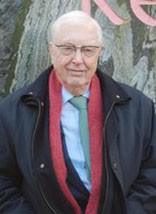
Professor Jan Rydberg
- Chalmers University of Technology 1962-1988
- Visiting Professor at Argonne National Laboratory 1959-1962
Profile
Jan Rydberg was born in 1923. His father was an inventor and researcher on sound communication, and head and co-founder of the Swedish Industrial Servants Union (SIF). His mother was a school teacher. Jan’s grandfather was the well-known spectroscopist Janne Rydberg (“the Rydberg constant”). In 1932 the family moved to Stockholm, where Jan attended the University receiving his MS (chemistry, physics, mathematics, psychology) in 1947 and PhD in 1955. From 1947 Jan was employed at the Research Institute of National Defence (FOA) in Stockholm, from which he retired as Research Director in 1963. From 1962-1988 Jan was Professor of Nuclear Chemistry at the Chalmers Technical University (CTH) in Gothenburg. After retirement Jan has published two textbooks, one on nuclear chemistry (3rd edition in 2002 of Radiochemistry and Nuclear Chemistry, with G Choppin and J O Liljenzin) and the other on solution chemistry (2nd edition in 2004 of Solvent Extraction Principles and Practices, with M Cox, C Musikas and G Choppin).
Jan Rydberg’s research began with establishing a nuclear chemistry laboratory at FOA, an activity which grew from one person to more than 100 over the next 20 years. His first publication in 1950 was to be followed by some 250 more in addition to over 10 patents, mainly in the field of the solution chemistry of the actinide elements and radioactive measurements techniques. In 1950 he received the prestigious Swedish-American Fellowship for studies in the USA. Also at this time he published a ground-breaking paper on the determination of formation constants for aqueous metal-organic complexes by solvent extraction. The systems studied in the following years were mainly actinide complexes of 2,4-pentanedione. His mentor during these years was the brilliant chemist Lars-Gunnar Sillén. During a stay (1959-1962) as Visiting Professor at the Argonne National Laboratory, USA, Jan collaborated with Jim Sullivan in introducing digital computers using least square calculations to determine formation constants with their statistical error. Since these calculations showed that the primary distribution data usually were unsatisfactory for obtaining accurate formation constants, in 1963 Jan invented with Hans Reinhardt an apparatus, nicknamed AKUFVE, for obtaining both faster and more accurate distribution data. This apparatus used special phase mixers, centrifugal separators and on-line measurements techniques. In collaboration with Gunnar Skarnemark and others, the AKUFVE technique was later expanded to the SISAK-technique for measuring and chemically identifying radionuclides mainly actinides and trans-actinides, with very short half-lives.
Together with David Dyrssen and Jol Liljenzin in 1966 Jan arranged the first international meeting on solvent extraction to include communist states in Göteborg, Sweden. He was a founder member of the International Committee for Solvent Extraction and has been a regular delegate and contributor to ISEC meetings.
Besides this basic research Jan participated in numerous applied projects, for example on-line cleaning of stainless steel heat cruds and the recovery of various waste metals from used batteries, computer boards, etc. He also eagerly took part in the debate on nuclear energy and was a member of the Swedish National Radioprotection Institute (1968-1988). He was consultant to the Swedish Nuclear Waste project, to the Volvo car company (on energy resources), to Stora Kopparberg AB, and others. He has been a very strong supporter of the use of nuclear power and has published many papers on nuclear wastes; global energy resources; migration of radionuclides in the environment, and risks from low level radiation.
Between 1980-1984 Jan was a visiting advisor at the Lawrence Livermore National Laboratory, USA, mainly on nuclear wastes, and in 1984-1985 Visiting Professor at the Universitée de Paris on rare earth complexation.
Since 1982 Jan has concentrated on writing text books. This was mainly carried out during time as a Visiting Professor at Florida State University with Gregory Choppin. Presently Jan is lecturing about his grandfather, the spectroscopist, but he is also a regular visitor to his Alma Mater and students at CTH.
During his career Jan has received many honours including: Commander of the Order of the North Star (Riddare av Nordstjärneorden); membership of the Royal Engineering Academy; membership of the Royal Society of Arts and Sciences in Gothenburg; and the Carl Hanson Medal. He has also been Chairman of the Swedish Chemical Society and Dean of Chemistry at CTH, Gothenburg.